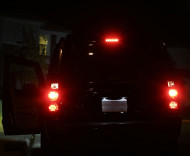8/12/2013
Indiana: Court Overturns Stop For Hole In Tail LightAppellate judges in Indiana reject traffic stop based on tiny hole in a tail light.

A small hole in a tail light does not justify a traffic stop, the Indiana Court of Appeals ruled last week. A three-judge panel said the evidence against Brad Kroft should have been suppressed because police should not have stopped his Jeep Commander on April 22, 2012.
At around 1:30am, Kroft had been driving with his wife Heidi on 96th Street near Hague Road in Indianapolis. There was a crack in his passenger-side tail light that created a dime-size hole in the otherwise fully functional stop light. A passing police officer saw it and decided he could issue a ticket.
"The lens on the taillight was cracked and it was emitting a white light to the rear of the vehicle," Indiana State Police Trooper Mike McCreary testified.
The state vehicle code requires all motor vehicles have two tail lamps that emit a red light that can be easily seen from a distance of 500 feet to the rear. At trial, Kroft argued that the traffic stop was illegal because his stop light met the requirements of the state code, but Marion Superior Court Judge Becky Pierson-Treacy agreed with Trooper McCreary and denied Kroft's motion to suppress the evidence. On appeal, prosecutors argued that the dime-sized hole allowed white light to escape and that the law only allows red light. The Court of Appeals did not buy that line of reasoning.
"The state, however, is mistaken about the requirements of Section 9-19-6-4," Judge Nancy H. Vaidik wrote for the appellate panel. "There is no requirement about 'only' red light being visible from a distance of 500 feet... Defendant's Exhibit A shows that while a miniscule amount of white light slipped through the dime-sized hole, the red light was overwhelming. And notably, Trooper McCreary did not allege that the passenger-side tail lamp did not emit red light plainly visible from a distance of 500 feet to the rear."
Prosecutors also argued that Kroft violated a separate statute requiring a driver to maintain his vehicle "in good working order." The appellate judges were not persuaded.
"Both of Kroft's tail lamps worked," Judge Vaidik wrote. "And there is simply no evidence that Kroft posed any danger to motorists approaching him from behind because of the dime-sized hole in his tail lamp. Trooper McCreary testified that he pulled over Kroft simply because there was white light coming out of the tiny hole; he did not testify that he had trouble spotting Kroft's Jeep from behind. Accordingly, Trooper McCreary did not have reasonable suspicion to stop Kroft pursuant to Section 9-21-7-1."
Kroft had been charged with driving under the influence of alcohol as a result of the stop. A copy of the decision is available in a 300k PDF file at the source link below.


